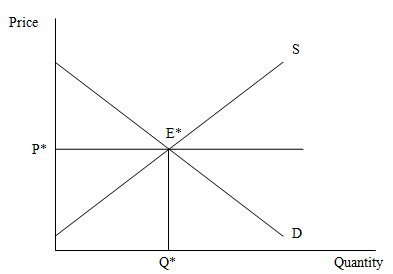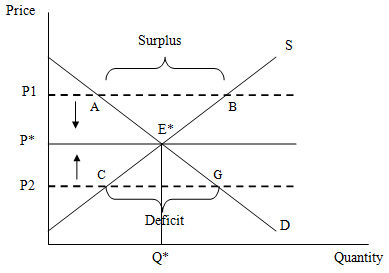Equilibrium is a very important concept in economics. The stability and efficiency of an economic system depends on equilibrium. The functioning of price and market mechanism determines the unique combination for equilibrium of the system. The interplay of the forces of demand and supply under price mechanism determine the prices of commodities and services at which goods and services would be bought and sold. When market mechanism of an economy performs efficiently, a stable equilibrium can be achieved by a country (Hatfield, Kominers, Nichifor, Ostrovsky, & Westkamp, 2013). The following essay focuses on various aspects of a stable economic equilibrium and whether the Australian economy is experiencing a stable equilibrium or not.
Economic equilibrium is a state, in which the economic forces, i.e. demand and supply are in perfect balance. In this state, the values of economic variables remain unchanged if there is no external influence. As per the definition, equilibrium in an economy or market occurs, when the quantity demanded and quantity supplied becomes equal (Corsetti, Kuester, Meier, & Müller, 2013). It is a condition when a price is established through the market competition, where the quantity demanded by the buyers or consumers is equal to the amount of products or services are produced or supplied by the producers. The price that is determined by this process is known as competitive price or market clearing price. This price will not change unless demand or supply changes. The quantity is also known as competitive or market clearing quantity (Foerster, 2016).

Figure 1: Market Equilibrium
(Source: Author)
Figure 1 illustrates a perfect market equilibrium. The demand and supply curve for a commodity or services intersect at point E*. At this point, the quantity demanded is equal to the quantity supplied. P* is the market clearing price and Q* is the market clearing quantity. If the demand and supply becomes unequal, the price goes either up or down from the equilibrium price and the situation of excess demand or excess supply arises in the market or economy.
In this context, the concept of stable equilibrium comes in. Equilibrium can be disrupted due to external forces. A stable equilibrium arises when a system gravitates back to equilibrium after it is shaken. The invisible hand, defined by Adams Smith in his book ‘The Wealth of Nations’, works as the mechanism that brings back a disturbed market situation into equilibrium (Baele, Bekaert, Cho, Inghelbrecht, & Moreno, 2015). Due to external shocks, such as, changes in demand and supply for any economic condition, the system equilibrium can be disturbed. Through some procedures, the system comes back to equilibrium again.

Figure 2: Stability in market equilibrium
(Source: Author)
Figure 2 depicts the situations, which can bring instability in the economy. When supply is higher than demand, excess supply or surplus arises in the market, shown by the line AB, and price rises to P1 from P*. Similarly, when demand is higher than the supply, excess demand or deficit arises in the economy, shown by the line CG, and price falls to P2. When there is stability in the system, the market adjusts itself to bring back the equilibrium. This means, during surplus, the market forces the price to go down to P* to reach an equilibrium and during deficit, the market pushes the price up to the equilibrium price. This way stability can be achieved in the system (Lima, Grasselli, Wang, & Wu, 2014).
The Australian economy is one of the most developed economies in the world. The economy is so stable that Australia has faced the longest run of economic growth among all the developed countries in the world. Since 1991, the country has never faced two consecutive quarters of negative growth or recession. During the Asian crisis and dot-com bubble, the Australian economy remained stable. Even during the global financial crisis of 2008, Australia was not directly hit by it. The country has low inflation, and lower unemployment rate and a GDP of 1.205 trillion USD in 2016 (Austrade.gov.au., 2017).
There are two different interpretations of the stability in economy of Australia. The first is the Australian model, which says, through the monetary and fiscal policies and exchange rate fluctuations, the uncertainties in the economy can be reduced. According to RBA governor Battellino, the exchange rate was flexible enough to go up and down as and when required. When the international economy was turbulent, the exchange rate went down and currency was depreciated (Battellino, 2013). The second interpretation was that, the country has tactfully utilized its resources to keep the growth going. Mining was the major industry of Australian economy. It created maximum number of jobs in the 1990s and 2000s. When the mining boom started to fade away, the other non-resource sectors were getting developed. Currently the service sector, especially the tourism, financial and insurance, information, media and telecom, etc. are the major service sector industries. Hence, even if there was turbulence in the economy, the Australian economy found out its own way to stabilize the situation (Thirlwell, 2013).
The country has got some other advantages, such as, educated and skilled work force, population, strong and stable political and social condition, locational advantage, open and liberal economies, which are used to maintain the stability of the economy, which in turn brings about economic growth for more than twenty six years (Austrade.gov.au., 2017).
It can be said that, the market has its own way to settle down. As described by Adam Smith, the force that works to bring about equilibrium in the system or market when it is disturbed, is known as invisible hand. Equilibrium is the situation when market demand equals market supply. For the nations, when the aggregate demand equals aggregate supply in the economy, it is known to be in equilibrium. With the record of consistent growth of Australia, it can be said that the country has experienced a stable equilibrium.
Austrade.gov.au. (2017). Australia has experienced the longest period of economic growth in the developed world. Retrieved from Austrade.gov.au. : https://www.austrade.gov.au/news/economic-analysis/australia-has-experienced-the-longest-economic-growth-among-major-developed-world
Baele, L., Bekaert, G., Cho, S., Inghelbrecht, K., & Moreno, A. (2015). Macroeconomic regimes. Journal of Monetary Economics, 70, 51-71.
Battellino, R. (2013, September 10). Twenty Years of Economic Growth. Retrieved from www.rba.gov.au: https://www.rba.gov.au/publications/bulletin/2013/sep/pdf/bu-0910-13.pdf
Corsetti, G., Kuester, K., Meier, A., & Müller, G. (2013). Sovereign risk, fiscal policy, and macroeconomic stability. The Economic Journal, 566.
Foerster, A. (2016). Monetary policy regime switches and macroeconomic dynamics. International Economic Review, 57(1), 211-230.
Hatfield, J., Kominers, S., Nichifor, A., Ostrovsky, M., & Westkamp, A. (2013). Hatfield, J.W., Kominers, S.D., Nichifor, A., OstrovskStability and competitive equilibrium in trading networks. Journal of Political Economy 121(5), 966-1005.
Lima, B., Grasselli, M., Wang, X., & Wu, J. (2014). Destabilizing a stable crisis: Employment persistence and government intervention in macroeconomics. . Structural Change and Economic Dynamics (70), 30-51.
Thirlwell, M. (2013). Can Australia Keep Beating The Economic Odds? . Retrieved from Pacific Standard: https://psmag.com/social-justice/australia-economy-recession-53744
Delivering a high-quality product at a reasonable price is not enough anymore.
That’s why we have developed 5 beneficial guarantees that will make your experience with our service enjoyable, easy, and safe.
You have to be 100% sure of the quality of your product to give a money-back guarantee. This describes us perfectly. Make sure that this guarantee is totally transparent.
Read moreEach paper is composed from scratch, according to your instructions. It is then checked by our plagiarism-detection software. There is no gap where plagiarism could squeeze in.
Read moreThanks to our free revisions, there is no way for you to be unsatisfied. We will work on your paper until you are completely happy with the result.
Read moreYour email is safe, as we store it according to international data protection rules. Your bank details are secure, as we use only reliable payment systems.
Read moreBy sending us your money, you buy the service we provide. Check out our terms and conditions if you prefer business talks to be laid out in official language.
Read more